C.A. Gray's Blog, page 9
May 20, 2024
The Body Electric, Robert Becker
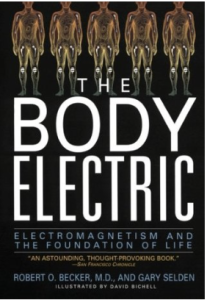
I almost never read paperbacks anymore, but I did this one because there was no e-book option, and I’d heard from so many different places that it was one of the most important books on the subject of how electricity and biology interact that it became worth it. I’m in process of transposing my highlights to my Evernote notebook by hand…
Becker was, I believe after reading this, not just a brilliant scientist willing and able to think outside the box, but a man of integrity as well, willing to fight against the establishment and risk his career in order to do what he could to alleviate human suffering. His experiments proved, stunningly, that electricity is not just involved in, but the driving force in healing and even regeneration. He first established this with salamanders, known to regrow limbs after their loss. But then he was able to establish that the same thing was possible in mammals as well, provided the positive polarity electrical signal sent out from the adjacent nerves were not interfered with by allowing the wound to heal over too quickly. His one lasting contribution to medicine was that this approach made its way into mainstream orthopedics for non-healing fractures, and now electrical currents are used to stimulate bone healing, and he won a Nobel Prize for this. But he had such big dreams, of helping regrow limbs for human beings, or triggering healing within the spinal cord itself for those who had suffered spinal cord injuries. It certainly sounds to me like all of these things are possible, based on the studies he performed, but I’ve never heard of any of it before. It seems that research on all these frontiers completely stopped, possibly in the 80s, when Becker’s research itself came to a halt.
Many of the powers-that-be came against him because Becker also used his insights into the power of electricity to heal to extrapolate that manmade electromagnetic frequencies could interfere with the body’s own signaling processes, and cause potentially tremendous suffering. Here the book was a repeat of many others I’ve read on the damage from EMF, but it was grounded in the concept that frequencies can heal as well as harm. How do we know which will do which? It seems that is an area ripe for research, which (so far as I know) still isn’t being done. The last chapter of the book was dedicated to all the political intrigue that conspired against him, and the psychological reasons behind it. Much of it, as Becker put it, wasn’t so much about financial gain as it was just about pride. The ‘establishment’ did not want anyone to challenge their own contributions to academia, which meant that anyone with a revolutionary idea didn’t get funding. Those who pandered to the existing power structure got grants, got published, and eventually made it into the pantheon of the old guard themselves… which only served to perpetuate the system. Eventually when a new idea couldn’t be hushed up, the old guard would mock on one hand, while taking credit for their opponents’ work on the other. Then of course, financial incentives of industry put pressure as well.
What all of this ultimately suggests to me is that a lot more miraculous things might be possible than we think, even from an objective scientific standpoint… but if it doesn’t make it into the mainstream, for whatever nefarious reasons, the rest of us may never know.
My rating: *****
Language: none
Sexual content: none
Violence: none
Political content: heavy, but not in a right/left kind of a way so much as the minutiae of academic machinations.
The post The Body Electric, Robert Becker appeared first on C.A. Gray.
May 17, 2024
Bad Therapy, Abigail Shrier
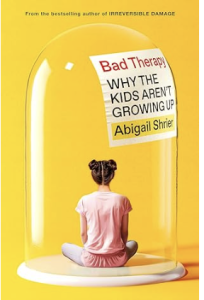
This book was eye-opening and enlightening, but also somewhat off-putting in its delivery.
I’ve had an inkling that therapy was doing more harm than good in more cases than not, in adults as well as children, though I couldn’t articulate the reasons for this nor prove it. I’m not a counselor, but I am a naturopathic doctor, and it seems that while most people who go to talk therapy for years *say* that it’s helping them, I don’t usually see evidence that it actually is. In fact, it seems they circle the same mountain over and over again, constantly digging up past trauma, meditating upon it, and reliving it. They never seem to truly heal. From a biblical standpoint, this makes sense to me… “as a man thinks in his heart, so is he.” What we spend our time meditating on shapes who we are. The Apostle Paul tells us that we should think about “whatever is good, true, holy, and praiseworthy”–which seems to be the exact opposite of talk therapy. On the other hand, stuffing our emotions is likewise unhealthy… the truth seems to be somewhere in between. We need to acknowledge and process, but then accept and move on, in order to truly heal (and I quite frankly don’t know how anybody can really do this without the help of the Holy Spirit, but at least Cognitive Behavioral Therapy seems to be useful enough to give people coping tools that don’t involve constant rumination.)
Shrier points out a lot of this, and argues that kids are even more susceptible to becoming traumatized through the act of such therapeutic approaches themselves, because they are at an impressionable age. They’re also in a power imbalance with an adult and a professional, which makes them more impressionable still. Meanwhile, adults who are now of their parents’ generation seem to have almost universally decided to give their children as conflict-free a childhood as possible, avoiding all negative emotions as if that is the goal of life. At the least sign of a negative emotion, they put them in therapy–and this, combined with the messaging kids get from their therapists, leads them to believe that they cannot handle the normal adversities of life. In Gen Z, she argues, it’s become almost a badge of honor to have one or more psych diagnoses and medications for coping. This also reinforces lack of agency–if kids (or really, anyone) believe that they are victims of their trauma, their diagnoses, or their biochemistry, they have no hope for growth or change. What they really need, Shrier argues, is to learn that they are capable, to face their fears, and to take responsibility in incremental amounts. She quotes Jordan Peterson on this, and I believe she also quoted Viktor Frankl as well, whose logotherapy espouses exactly the same thing. Face the tiger, and you may find that it was made of paper all along. But if you don’t face it, you’ll spend your whole life in hiding, your life becoming smaller and smaller to manage your fears.
I listened to the book read by the author, and she was so often dripping with sarcasm… which I like, to a point, and I largely agreed with her. Even so, it was the type of sarcasm that was not so much funny as it was scathing and derisive. While I get that this was a backlash against the coddling that she feels is the problem in the first place, I think there could have been a happy medium. I’ve certainly had the experience of realizing that, in certain cases, I was my own worst enemy. Fortunately I realized this with the help of the Holy Spirit, who is kind, and who never condemns. The book could certainly have benefitted from a healthy dose of grace, in my opinion.
My rating: ****
Language: none
Violence: none
Sexual content: none
Political content: heavy, and interestingly enough on both sides… the premise of the book is very right-leaning, and yet she simultaneously holds several left-leaning ideologies that she states throughout the book as though they are indisputable.
The post Bad Therapy, Abigail Shrier appeared first on C.A. Gray.
May 9, 2024
Mort, by Terry Pratchett
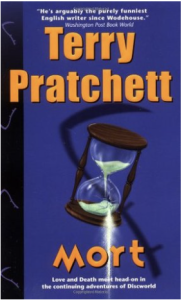
This was my first introduction to Terry Pratchett, I think, aside from the heaven/hell comedy that he co-wrote with Neil Gaiman (which I remember not finishing). This isn’t at ALL what I thought his writing style was, but I really liked it! He’s hilarious, and irreverent in a throughly British way (which I find inherently endearing). While apparently the Discworld series is immense, this was my first introduction to it–and it can be read easily as a standalone.
The story follows Mort, a young boy looking to apprentice for a career. He finds himself apprenticed to Death, personified as a rather droll skeleton with glowing blue eyes, who really just wants to be a normal guy. Death is attempting to train his replacement so that he can go work as a fry cook in a diner. After following Death for one or two “cases,” Death sends Mort out on his own. The third case Mort attempts alone is Princess Keli, whom he thinks is quite cute, and he ends up saving her life instead–which puts an enormous rift in the space-time continuum, between the world that now is and the world that should be. In the process of trying to put this right while hiding his screw-up from Death, Mort and Death’s adopted daughter have to seek the help of an ancient wizard who somehow never officially died, and Mort himself begins to take on more and more of Death’s own characteristics in the process…
A lot of fun. I may pick up more in the series.
My rating: ****
Language: none
Violence: comedic only
Sexual content: none
Political content: none
The post Mort, by Terry Pratchett appeared first on C.A. Gray.
May 1, 2024
Surprised by Joy
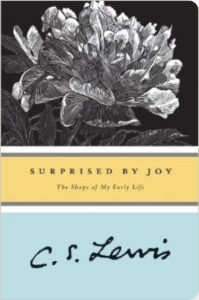
I can’t believe I’d never read this before! I love C.S. Lewis, but I’d purposely avoided this one because his wife was Joy and she died of cancer, and I thought this was that story. But no: it’s his autobiography, sort of, but more the story of how he became a believer. The beginning is very autobiographical, describing the boarding school he went to, and his life in his nuclear family both before and after his mother died. But what really struck me about this portion of the story was how much detail he went into not about the actual details of his external life, but about his internal life of ideas. I can so identify with that… I think anyone “bookish” can. A lot of the time, what happens in my head is more interesting than what’s actually happening in my life. In Lewis’s case, this was a critical part of his ultimate conversion: the idea that “joy” was something to be found in ideas, in philosophy, and in ultimately finding the source of all of the concepts he’d always loved.
My rating: *****
Language: none
Sexual content: none
Violence: none
Political content: none
The post Surprised by Joy appeared first on C.A. Gray.
April 26, 2024
The Rainbow and the Worm
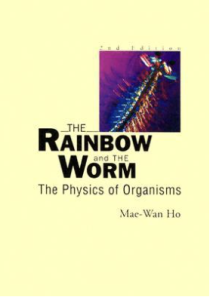
This book blew my mind.
Warning: it’s not a light read. She literally has physics equations scattered throughout the text, and she goes into a ridiculous amount of minutiae–to the point where I almost gave up toward the beginning. But as I kept reading, I began to understand, in a vague way that I could never quite put my finger on even when I finished, that this is an incredibly important work. It touches on the concept of what life is, not just in a philosophical but in a physical, biological, and quantum mechanical way. It describes how life must be a coherent system, in the sense of communication at almost light speed (which defies the generally understood biochemical explanations), and suggests that the crystalline water inside cells (referencing The Fourth Phase of Water, Gerald Pollack) plays a fundamental role in this communication. Not only that, but this structured water can thus refract light shone through it into a rainbow, hence the title–but only when the organism is alive. The moment it dies, the rainbow vanishes, suggesting that order and life are, in some way, synonymous.
Ho wrote for her peers, not really for the general public, and she didn’t seem much bothered with making herself easily understood, But it’s well worth the effort… I’ve since found myself going down the rabbit hole, trying to find similar books to give me a firmer grasp of her ideas, since she herself didn’t seem to publish much else.
My rating: *****
Language: none
Sexual content: none
Violence: none
Political content: none
The post The Rainbow and the Worm appeared first on C.A. Gray.
April 22, 2024
Breath, James Nestor

Fabulous! I never thought an entire book could be written on the subject of breathing. Not only is it possible, but the history of “pulmonauts” is a fascinating one.
Some of the pearls from this book include the concept that the “use it or lose it” idea applies to breathing through your nose, and into the deepest recesses of your lungs, too. You can practice, and regain what has been lost. And a host of benefits await those who do.
There is such a thing as the perfect breath: 5.5 seconds in, and 5.5 seconds out. But not only that, there are a whole host of breathing techniques that can train your body’s utilization of oxygen to become more efficient.
CO2 is far more than just a biological waste product; it’s a critically important molecule in and of itself. So much so that training to “hold your breath” is incredibly beneficial.
A patient recommended this to me and I’ve since recommended it to about twenty more. Well worth the read.
My rating: *****
Language: none
Sexual content: none
Violence: none
Political content: none
The post Breath, James Nestor appeared first on C.A. Gray.
April 19, 2024
Elon Musk

This was a fascinating character portrayal – as good as if it were fiction! Elon Musk is such an enigma–how does one man accomplish as much as he has? What kind of a person does one have to be? This answers the question, more or less. Isaacson’s portrayal certainly appeared to me to be (mostly) unbiased, depicting Musk as hard-driving, brilliant, and hilarious at times, but also haunted, flawed, and often a complete jerk. I have to wonder, since it became clear as I listened that Musk and Isaacson had become friends (not too surprising since Isaacson would have had to have followed him around for years in order to paint such a clear picture of the man), whether anything that appears in the book is a betrayal of a confidence. If I were Musk, I’d certainly feel overly exposed. But then again, if he hadn’t shown all sides of the man, it wouldn’t have been an interesting read, and I wouldn’t have found Musk nearly so sympathetic as I did. By the end, I felt like Musk was my friend… albeit a mercurial one around whom I’d probably feel I needed to walk on eggshells.
I’ve never read a biography of someone who was still alive that I can recall before, so it’s also interesting to read what was going on in Musk’s life when various things I read about in the headlines were occurring. My one complaint about the way the story was told was that Isaacson inserted his own politics in the narrative, when Musk’s changing politics required coverage. He did it in such a way, though, as to imply that there was only one “right” way to view various situations, and Musk fell on the wrong side of it. I found that annoying, though it didn’t ruin the book for me.
My rating: ****1/2
Language: a LOT. But that’s just because all the people in the book curse a lot, I guess.
Sexual content: none
Violence: none
Political content: a decent amount
April 12, 2024
All Stirred Up
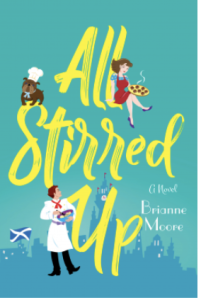
This was a cute chick lit story that checked all the boxes, and felt just a bit like a Beth Moran story too, in the sense that it was clean and feel-good. It’s also very much like every other story similar to it, but sometimes that’s ok.
A 30-something single girl runs into an ex from years ago, whom she never got over. He never got over her either, but she broke his heart. He thinks she never really cared about him, while she thinks he’ll never forgive her, even though she had her reasons and crises going on at the time. They’re both chefs, and she manages a family restaurant. He comes back into town, and opens his own restaurant. A malicious journalist pits them against each other, creating tension, until they realize what’s going on and manage to fall back into at least friendship. Complications with those around them ensue, and the old story of what happened between them, as it really was, finally comes to light. Then there’s a happily ever after.
I finished it a few weeks ago and I honestly don’t remember a lot more details than that, because as I said, it’s pretty forgettable. But I enjoyed it while I was listening.
My rating: ****
Language: if there was any, it wasn’t much
Violence: none
Sexual content: a little but not much
Political content: if there was any, it wasn’t much
The post All Stirred Up appeared first on C.A. Gray.
April 5, 2024
The Power of Awe, Jake Eagle and Michael Amster
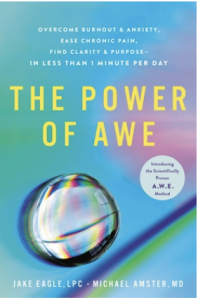
This was very inspiring! As a naturopathic doctor I’ve read and heard ad nauseum about the benefits of mindfulness and meditation–of course it’s true, but it’s not easy for a lot of people in our modern world to practice. I’ve had to struggle myself to do 5 minute meditations here and there when I feel I need it, and while I do feel it’s done me a lot of good, I love the fact that this is an accessible approach to achieving something quite similar, that happens to be available even to those who struggle to calm their “monkey minds,” or who are in pain, or exhausted, or otherwise incapable of the discipline required for meditation. In less than a minute, we can experience awe just by fully focusing our attention and admiration on something outside of ourselves, breathing in deeply, holding it and our focus, and then breathing out. I’ve been practicing this myself since reading the book, and I do feel that it will be very beneficial if I can make it a habit. I’ve felt I needed to get better at being fully present in the moment for some time now, noticing my surroundings.
Even though the practice can be described in a sentence, though, I still think the book is well worth a read. It gives the studies to back it up, inspiring personal stories, and guidance on how to choose what to fix your attention on, from things outside of yourself, to an idea or a memory, a sound or a smell or a taste. It’s a great guide for those who need help getting started.
My rating: *****
Language: none
Sexual content: none
Violence: none
Political content: some, if you consider a scientific book that has to relate everything back to evolution political. Why MUST they all do that when it’s not even relevant to the topic at hand?
The post The Power of Awe, Jake Eagle and Michael Amster appeared first on C.A. Gray.
March 28, 2024
Jaguar Prophecies
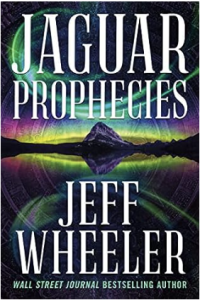
This is definitely a different genre for Jeff Wheeler — urban fantasy rather than high fantasy. It’s set in the real world, present day, and this continues the Dresden Codex series. I wasn’t that into the first book in this series, for some reason. I think I just didn’t identify with the characters enough to be emotionally involved with them. I felt the same at the beginning of this book, but they grew on me as the stakes grew even higher.
The story follows Jonathan Roth, a NYT bestselling author whom I suspect is at least to some degree based on Wheeler himself, and his teenage children, Suki, and twin boys. His wife Serena didn’t appear in this installment, as at the end of the last book, Roth was forced to leave her behind in Mexico in a diabetic coma after they won the Mayan Death Games, with the assumption that she would never wake up. His family won the financial spoils from their opponents, as well as a promise that they would survive the coming apocalypse, when the Jaguar priests from the ancient Maya taking over the world in retaliation for their conquest thousands of years earlier. But they lost their freedom, as they weren’t allowed to speak of what they knew, and Jacob, the leader of the shapeshifting priesthood, kept tabs on them at all times.
Suspecting that they were not entirely safe, Roth found a safehouse off the grid, and with his newfound wealth, hired private guards for his family. Meanwhile, Roth couldn’t sit by and wait for the end of the world, though; instead, he wrote a new book under a pseudonym about all of it, and was doing research to learn more of their plans and ultimately expose them. This is what sets off the chain of events in this book: Jacob and his henchmen are after Roth and his family once again, and Roth must enlist the help of a skeptical FBI agent in order to survive.
Once the action gets going, I raced through to the end.
My rating: ****
Language: none
Sexual content: none
Violence: none
Political content: none
The post Jaguar Prophecies appeared first on C.A. Gray.



